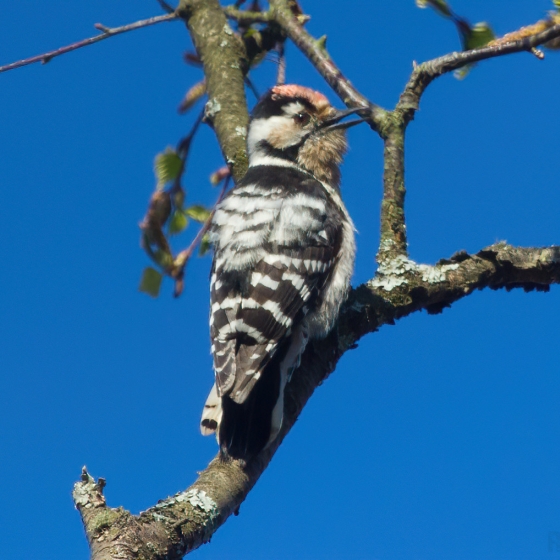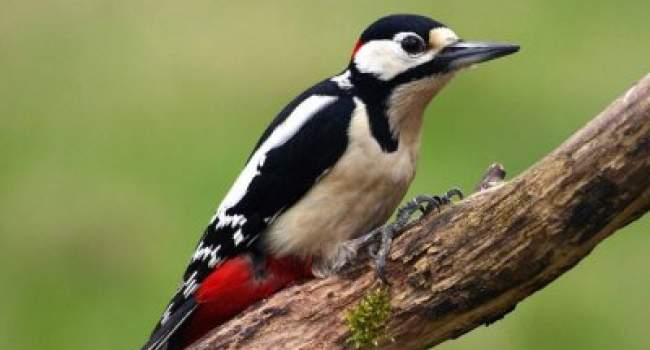Lesser Spotted Woodpecker
Dryobates minor (Linnaeus, 1758)
LS
 LESWO
LESWO  8870
8870

Family: Piciformes > Picidae

This sparrow-sized woodpecker, with its black and white plumage and red crown, has been lost from many of its former haunts.
Restricted to England and Wales, we have seen substantial declines since the 1980s, the reasons for which remain unknown. The loss of open woodland habitats may be one factor, but others – including possible competition with an expanding Great Spotted Woodpecker population – also need to be considered.
Lesser Spotted Woodpeckers start their breeding season early in the year, their drumming display one of the few indications of their presence.
Identification
Lesser Spotted Woodpecker identification is sometimes difficult. The following article may help when identifying Lesser Spotted Woodpecker.
Identifying Great Spotted Woodpecker and Lesser Spotted Woodpecker

Are you unsure of the identity of a black and white woodpecker coming to your garden feeder? Great Spotted or Lesser Spotted? Let this workshop help you to confidently identify these two species.
SONGS AND CALLS
Listen to example recordings of the main vocalisations of Lesser Spotted Woodpecker, provided by xeno-canto contributors.
Other
Call
Develop your bird ID skills with our training courses
Our interactive online courses are a great way to develop your bird identification skills, whether you're new to the hobby or a competent birder looking to hone your abilities.
Browse training coursesStatus and Trends
Population size and trends and patterns of distribution based on BTO surveys and atlases with data collected by BTO volunteers.
CONSERVATION STATUS
This species can be found on the following statutory and conservation listings and schedules.
POPULATION CHANGE
The Lesser Spotted Woodpecker has declined significantly and very rapidly since around 1980, following a shallower increase; it had already contracted in range between the first two atlas periods (Gibbons et al. 1993), and has subsequently disappeared from many more of its former localities (Balmer et al. 2013). The species qualifies easily for red listing. Although the Common Bird Census was able to monitor populations until that scheme ended in 2000, the species is now so rare that it is recorded on only 10-20 Breeding Bird Survey squares annually and hence BBS results are not routinely published. The combined CBC/BBS trend is shown in spite of the low BBS sample size to reflect the substantial long-term decline which has occurred. The species is now so rare that Rare Breeding Birds Panel figures provide an alternative way to monitor the shorter-term trends: all UK breeding records since 2010 should be forwarded to the RBBP, who have established recording criteria. Lesser Spotted Woodpecker has been one of the most strongly declining bird species in Europe, with widespread steep decrease since 1980 (but with a wide confidence interval: PECBMS 2007): the European trend is described currently as 'uncertain', although the trend graph shows a steep decline in the early 1980s (PECBMS: PECBMS 2020a>).
| UK breeding population |
-81% decrease (1997–2022) 
|
DISTRIBUTION
The Lesser Spotted Woodpecker's winter and breeding distributions are very similar, though with more squares occupied in winter, perhaps due to dispersal, but also perhaps a greater detectability in February when birds are displaying. London and surrounding counties form the largest remaining area of continuous breeding occupation; more isolated 10-km squares might hold no more than a single pair.
Occupied 10-km squares in UK
| No. occupied in breeding season | 560 |
| % occupied in breeding season | 19 |
| No. occupied in winter | 615 |
| % occupied in winter | 20 |
European Distribution Map
DISTRIBUTION CHANGE
Losses of range have been extensive in all regions, but especially in East Anglia and in northern and westernmost England. Overall, the breeding range contracted by 11% up to the 1988–91 Breeding Atlas and subsequently by a further 34%.
Change in occupied 10-km squares in the UK
| % change in range in breeding season (1968–72 to 2008–11) | -41.1% |
| % change in range in winter (1981–84 to 2007–11) | --20.3% |
SEASONALITY
Lesser Spotted Woodpeckers are recorded throughout the year but most often detected during late winter and early spring during territorial defence.

Movement
Information about movement and migration based on online bird portals (e.g. BirdTrack), Ringing schemes and tracking studies.
RINGING RECOVERIES
View a summary of recoveries in the Online Ringing Report.
Biology
Lifecycle and body size information about Lesser Spotted Woodpecker, including statistics on nesting, eggs and lifespan based on BTO ringing and nest recording data.
SURVIVAL & LONGEVITY
View number ringed each year in the Online Ringing Report
Maximum Age from Ringing 
|
6 years 4 months 9 days (set in 2010) 
|
Typical Lifespan 
|
7 years with breeding typically at 1 year |
Adult Survival 
|
0.85 (Male: 0.85± Female: 0.85±)  
|
BIOMETRICS
Wing Length 
|
Adults | 88.1±2.2 | Range 84–91mm, N=64 |
| Juveniles | 87.9±2.4 | Range 84-91mm, N=29 | |
| Males | 88.1±2.1 | Range 85–92mm, N=42 | |
| Females | 88.1±2.3 | Range 84–91mm, N=22 |
Body Weight 
|
Adults | 20.7±1.1 | Range 19.0–22.5g, N=59 |
| Juveniles | 20.5±1.1 | Range 19.1–22.0g, N=28 | |
| Males | 20.8±1.1 | Range 19.1–22.6g, N=38 | |
| Females | 20.5±1.1 | Range 19.0–22.0g, N=21 |
Feather measurements and photos on featherbase 
CODES & CLASSIFICATION
Ring size 
|
B |
Field Codes 
|
2-letter: LS | 5-letter code: LESWO | Euring: 8870 |
For information in another language (where available) click on a linked name
Research
Interpretation and scientific publications about Lesser Spotted Woodpecker from BTO scientists.
CAUSES AND SOLUTIONS
Causes of change
The demographic causes of decline are not yet known and, although there is low breeding success in some populations, the reasons for the decline are unclear.
Further information on causes of change
The demographic causes of decline are not yet known, and although there is low breeding success in some populations the reasons for the decline in the UK and elsewhere in Europe are unclear (Charman et al. 2009). A study of nest data in Britain found that the mean number of young fledged has declined since the 1980s, possibly exacerbated by the generally warmer springs, with loss of chicks, probably as a result of starvation, being the main cause of low productivity; hence this could potentially have contributed to the population decline (Smith & Smith 2020). However, a detailed field study in Sweden provided good evidence that neither clutch size, brood size in successful nests, fledging success in successful nests nor mean nestling weight differed significantly there between years, despite a threefold difference in population variation (Wiktander et al. 2001).
Loss of open woodland is one factor that has been suggested to have contributed to declines in this species. Lesser Spotted Woodpecker is a species that requires mature, open woodland and large areas of woodland at a landscape scale (Wiktander et al. 2001, Charman et al. 2010). Wiktander et al. postulate that the decrease in the area of deciduous forest in Sweden is probably one cause of this species' decline, although they present no specific evidence to support this (Wiktander et al. 1992). Loss of dead wood within woodlands has been proposed as another factor; however, given that dead wood has increased in Britain (Amar et al. 2010) this seems an unlikely cause here. A field study in Poland provided evidence that Lesser Spotted Woodpecker presence is closely correlated with the amount of dead wood and large deciduous trees (Angelstam et al. 2002). In their review of the causes of declines of woodland birds Fuller et al. (2005) state that reductions in small-diameter dead wood suitable for foraging may be a factor in the decline, although recent surveys provided evidence that there was no difference in dead-wood abundance between occupied and unoccupied woods (Charman et al. 2010). However, dead snags have a high turnover and were found to be suitable for nesting sites by woodpeckers for only a few years after death and, furthermore, dead-wood conditions may now be more favourable for Great Spotted Woodpeckers (Smith 2007).
A third hypothesis relates to competition and predation. A field study in Sweden found that Great Spotted Woodpeckers compete with Lesser Spotteds for insect food in dead wood when spruce seed crops are low (Nilsson et al. 1992), but evidence for this in Britain is limited (Charman et al. 2010). The two species may compete for nest sites, since they overlap considerably in their use of nesting substrates (Glue & Boswell 1994). Amar et al. (2006) found that Lesser Spotted Woodpecker decreased more heavily in woods with relatively high numbers of grey squirrel dreys but there was no other evidence that squirrel density was a significant factor in declines.
Changing climate has been found to have an impact on survival and reproduction in some populations. In Norway, a positive relationship between spring numbers of Lesser Spotted Woodpecker and previous June temperatures has been interpreted as an effect of temperatures on woodpecker survival and reproduction during the breeding season (Steen et al. 2006, Selas et al. 2008). Steen et al. (2006) also found that winter temperatures exhibit a direct positive effect on winter survival. However, given that there has been a general trend for increasing temperatures in the UK (see here), it seems unlikely that changes in climate have been responsible for Lesser Spotted Woodpecker declines. Work in Sweden and Germany suggests that changes in phenology could play a role in breeding success, finding that declines in food availability during the breeding season are likely to be related to seasonal declines in reproductive performance as woodpeckers adjust their timing of breeding to coincide with the seasonal food peak (Wiktander et al. 2001, Rossmanith et al. 2007). However, there is little further evidence for this. In Britain, breeding success has fallen and is lower than in recent studies in Germany and Sweden; chick mortality is especially high, most probably related to food shortages in the breeding period (Charman et al. 2012, Smith & Charman 2012).
Information about conservation actions
The species requires large areas of mature, open deciduous woodland with deadwood at a landscape scale (Wiktander et al. 2001; Charman et al. 2010), but the decline has occurred even in areas where this habitat has apparently been available. Reasons for the substantial decline of this species remain unclear (see Cause of Change section, above) and investigations are ongoing to try to identify measures that may reverse the downward trend (Smith & Charman 2012).
Links to more studies from ConservationEvidence.com
- Ring-barking of Scots pine Pinus sylvestris trees to create standing deadwood on heathland at Great Ovens, Dorset, England
- Evidence of positive indirect effects within a community of cavity-nesting vertebrates
- Experimental reintroduction of red-cockaded woodpeckers
Read more studies about Lesser Spotted Woodpecker on Conservation Evidence >
Would you like to search for another species?












Share this page